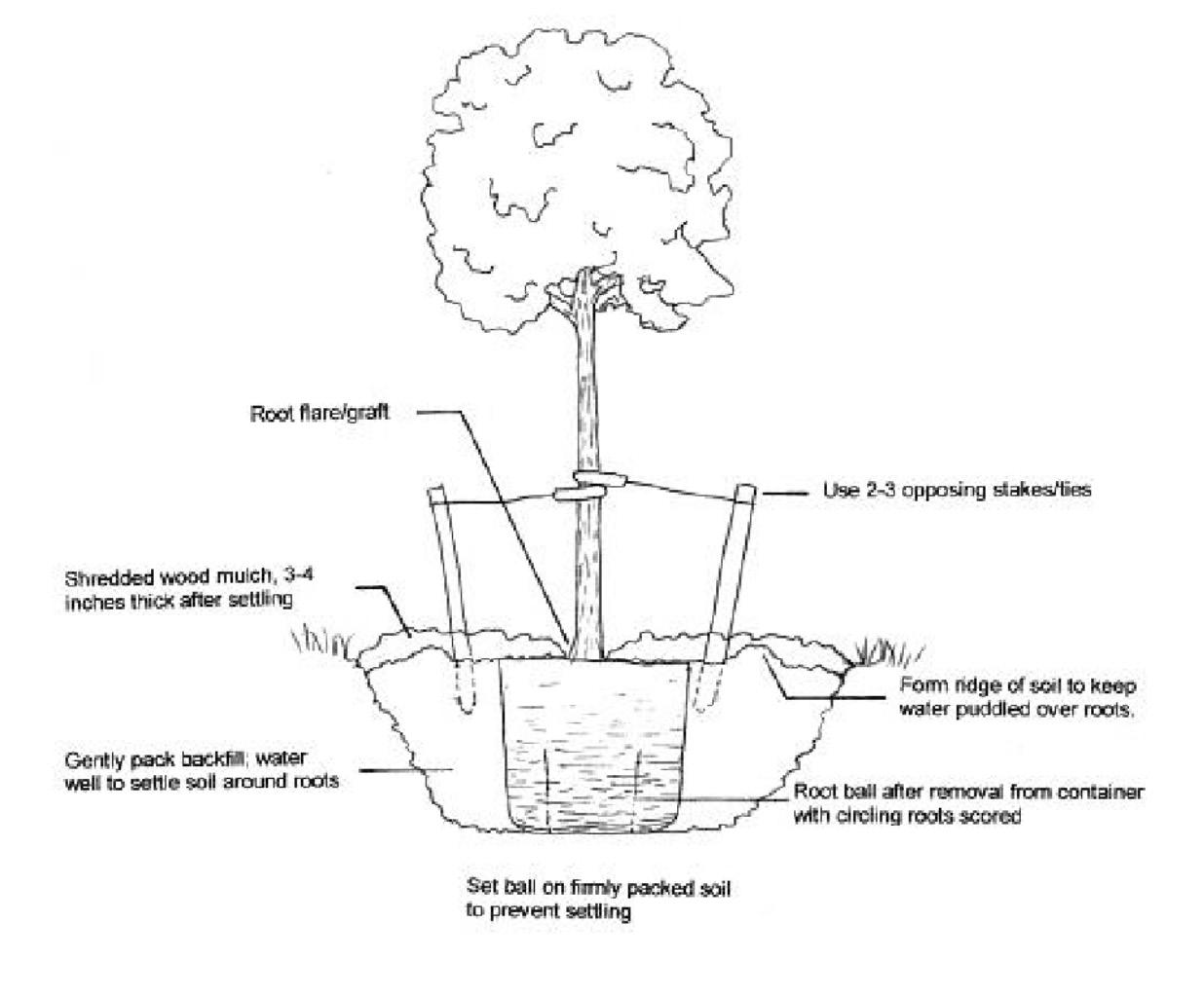
3 minute read
CAMPUS TREE CARE PLAN
1.00.0 TREE PLANTING SPECIFICATIONS
1.01.0 Projects on UTRGV shall adhere to specifications based on the most recent editions of the following for tree planting:
Advertisement
1.01.1 American National Standards Institute (ANSI)
A300– 06 Planting and Transplanting Standards (2012)
1.01.2 American National Standards Institute (ANSI)
Z60.1-2013, standards for nursery stock
1.01.3 ANSI Z133.1 Safety Standards
1.01.4 Related ISA Best Management Practices (BMP’s)
1.02.0 Planting Soil: refer to UTRGV soil specifications and standards.
1.03.0 Irrigation: Refer to UTRGV landscape irrigation specifications. Note: Tree irrigation zones (valves) must be separate from other landscape irrigation zones. Every newly planted tree shall have a minimum of 1 irrigation bubbler installed (drip allowed), with the goal of watering as much of the root ball surface area as possible.
1.04.0 STAKING:
Place 3 t-posts (or similar) around each tree, and drive into existing soils. Wire, rope, or other methods of securing the tree shall not injure the bark. Stakes should be removed after the first growing season. Posts must be marked for safety (painting, caps, etc.). Six foot t-posts are the typical means of staking.
1.05.0 TREE GRATES:
Only in instances of pier and beam (floating-deck) walk areas will tree grates be permitted. These are areas where a significant gap exists between top of root ball of newly planted trees and the finished elevation of the hardscape. No tree grates shall be installed on existing mature trees.
1.06.0 TYPES OF NURSERY STOCK:
Trees and shrubs can be purchased as bare root, in containers or pots, or with root balls wrapped in burlap (B&B). Bare root trees and shrubs are usually less expensive than containerized or B&B plants, but are available only during their dormant season, usually in early spring. Containerized and B&B trees and shrubs are available throughout the growing season. The preference is for all plant material to be from local seed source. UTRGV landscape services shall receive at least 48-hour notice of delivery of plants to job site.

1.06.1 Planting of Bare Root Trees
1.06.11 Roots of bare root trees should be moist and protected at all times prior to planting. Prepare planting hole for each plant before removing it from their protected area.
1.06.12 The hole prepared shall be large enough to spread the roots without crowding. The sides of the hole shall be roughed sure to ensure glazing of hole does not occur.
1.06.13 Inspect roots and prune any that appear broken or damaged.
1.06.14 Place the roots in the hole at a level so that the soil surface will be at the same level where the plant was previously growing, as indicated by the slightly darker area of the trunk. Trees should be planted so that trunk flare is visible above the final soil surface.
1.06.15 Backfill with existing soil from excavated hole, and add the soil into the hole a few inches at a time, firming the soil after each addition. While backfilling, be sure the plant remains vertical and be careful not to damage roots. Use water to settle the soil around the roots while backfilling. Do not compact wet soil.
1.06.16 After backfilling is complete, form a ridge of soil (berm) around the edge of the hole to hold water on the roots.
1.06.17 Thoroughly water the plant at installation. Mulching with a local hardwood mulch helps retain moisture and deter weeds. Mulch root ball with 3” of mulch and keep mulch 1-2 inches away from the plant’s trunk to prevent damage from moisture. cannot currently be displayed.
1.06.2 PLANTING OF CONTAINERIZED TREES
1.06.21 Prepare a planting hole as described in #2 above. The depth of the hole should be the same as the soil in the container, and the width of the hole should be at least twice the width of the container.
1.06.22 Once the planting hole is prepared, lay the containerized tree or shrub on its side and gently slide the plant out of the container. It may be necessary to push on the sides of the container to loosen the root ball. If the plant has become root-bound and roots have circled the container, slice the root ball in 4-5 places with a pruning saw or hand pruners that will cleanly cut roots. Loosen exterior of root ball to promote lateral root growth.
1.06.23 Place the intact root ball in the hole. Trees should be planted so that trunk flare is visible above the final soil surface. Ideally, this is the same level at which the tree was growing in the container, but many trees are buried several inches deep.
1.06.24 Backfill the soil into the hole a few inches at a time, firming the soil after each addition. While backfilling, be sure the tree remains vertical.
1.06.25 Form a ridge to hold water and stake and protect trees as described above under “Planting Bare Root Trees and Shrubs.”









